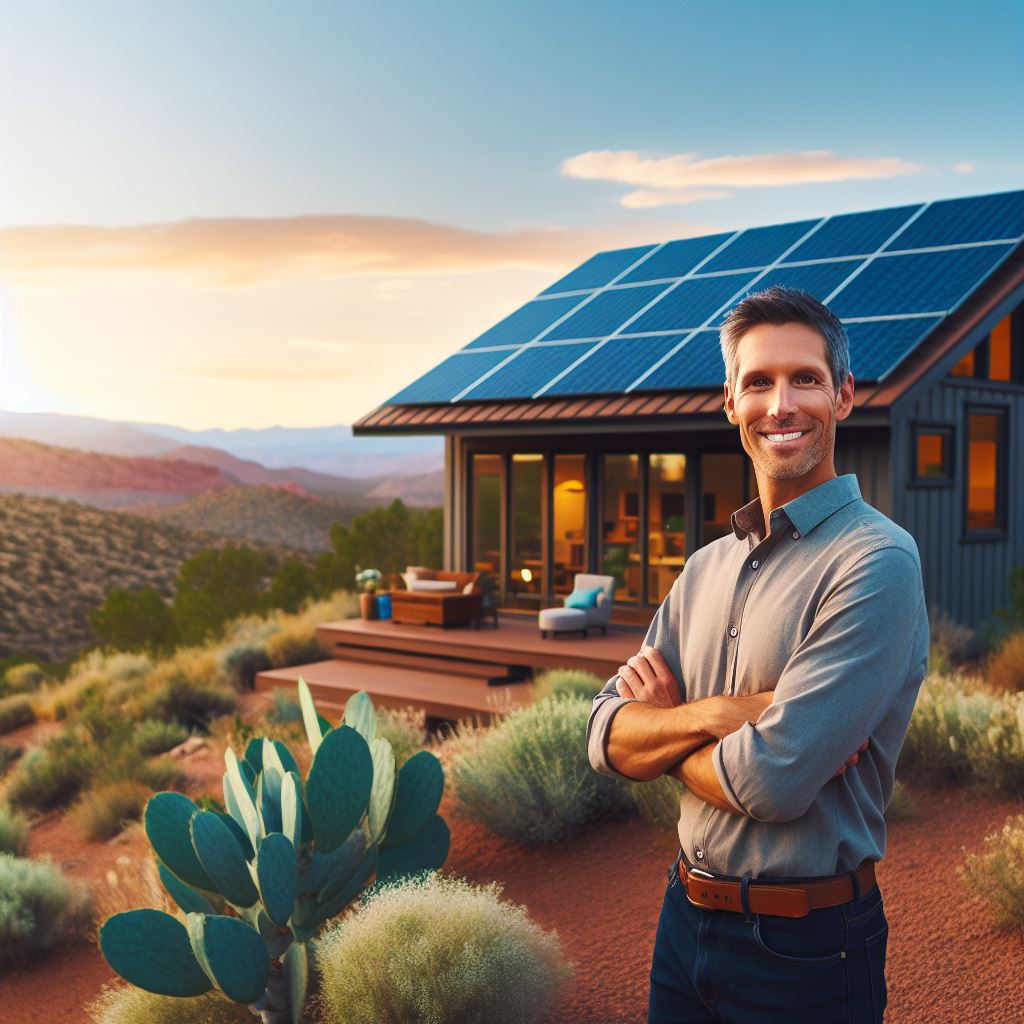Introduction
Green investing is a growing trend that focuses on environmentally-friendly investments.
These investments aim to generate financial returns while also making a positive impact on the environment.
One particular area of interest is solar homes in the Southwest region, where the abundant sunshine offers great potential for harnessing solar energy.
Solar homes in the Southwest utilize solar panels to convert sunlight into electricity, which can then be used to power homes.
This not only reduces reliance on traditional energy sources but also helps to reduce carbon emissions and combat climate change.
The Southwest region, with its sunny climate, is particularly well-suited for solar energy production.
The purpose of this blog post is to explore the benefits and potential of investing in solar homes in the Southwest.
By investing in solar homes, individuals can contribute to a cleaner and more sustainable future while also enjoying potential financial returns.
Additionally, this post will discuss the various incentives and support available for solar home investments in the Southwest.
In essence, green investing, specifically in solar homes in the Southwest, presents an exciting opportunity for investors.
By embracing renewable energy sources, individuals can not only support environmental sustainability but also potentially earn financial returns.
In the following sections, we will explore the advantages and considerations of investing in solar homes in the Southwest region.
Benefits of Green Investing
Environmental benefits of investing in solar homes
- Reduced carbon footprint, as solar energy is clean and sustainable.
- Decreased reliance on fossil fuels, which helps combat climate change.
- Preservation of natural resources by utilizing renewable energy sources.
- Improved air quality and reduced pollution in the local community.
- Protection of wildlife habitats and biodiversity in the Southwest region.
Potential for cost savings on energy bills
- Lower monthly electricity bills due to generating your own solar power.
- Net metering allows homeowners to sell excess energy back to the grid, offsetting costs.
- Long-term financial benefits, as solar panels have a lifespan of 25-30 years.
- Hedging against rising electricity prices, ensuring stability and savings.
- Federal and state incentives, such as tax credits and rebates, further reduce installation costs.
Economic growth and job creation in the renewable energy sector
- Expanding solar industry creates new opportunities for businesses and entrepreneurs.
- Job growth in manufacturing, installation, and maintenance of solar systems.
- Spillover effects on other sectors, such as research and development of innovative technologies.
- Local workforce development through training programs and apprenticeships.
- Attraction of green investments and funding to the Southwest region, stimulating economic growth.
By investing in solar homes in the Southwest, individuals can contribute to a greener future while reaping numerous benefits.
The environmental advantages are significant, allowing homeowners to reduce their carbon footprint, protect the environment, and promote sustainability.
Furthermore, the potential for cost savings is substantial, with decreased energy bills, opportunities for selling excess energy, and long-term financial gains.
Finally, embracing renewable energy presents economic growth and job creation prospects, attracting businesses, and fostering local workforce development.
Read: Eco-Friendly Real Estate in the Pacific Northwest
Overview of Solar Homes in the Southwest
When it comes to solar homes in the Southwest, several factors contribute to their popularity in the region.
Factors contributing to the popularity of solar homes in the region
- The abundance of sunshine in the Southwest makes it an ideal location for solar energy.
- Government incentives and tax benefits encourage homeowners to invest in solar panels.
- The decreasing costs of solar panel installations have made it more affordable for homeowners.
The combination of these factors has resulted in the widespread adoption of solar homes in the Southwest.
Statistics on the growth of solar homes in the Southwest
The growth of solar homes in the Southwest has been remarkable in recent years.
According to a recent study, the number of solar-powered homes in the Southwest has tripled in the last decade.
In Arizona alone, there has been a 400% increase in solar installations, making the state a leader in solar energy adoption.
Nevada and New Mexico have also seen significant growth, with a 300% and 200% increase in solar homes respectively.
These statistics highlight the region’s commitment to clean energy and its recognition of the benefits of solar power.
Examples of successful solar home projects in the region
Many successful solar home projects have been implemented in the Southwest, showcasing the potential of solar energy.
In Tucson, Arizona, the Davis residence is an exemplary solar home project.
Using a combination of rooftop solar panels and energy-efficient design, the Davis family has achieved energy independence and substantial cost savings.
Another notable project is the Solara community in Las Vegas, Nevada.
This development incorporates solar panels into each home, significantly reducing residents’ energy bills and minimizing environmental impact.
In New Mexico, the Santa Fe Solar Homes community stands as a testament to the region’s commitment to sustainability.
The entire neighborhood runs on solar power, providing clean energy to each household.
These successful solar home projects serve as inspirations for others looking to embrace renewable energy in the Southwest.
In fact, solar homes in the Southwest have gained popularity due to factors such as abundant sunshine, government incentives, and declining installation costs.
The region has witnessed significant growth in solar homes, with impressive statistics reflecting the adoption of solar energy.
Successful projects like the Davis residence, Solara community, and Santa Fe Solar Homes demonstrate the viability and benefits of solar homes in the Southwest.
With a bright future ahead, solar homes continue to shine in the region.
Read: New Investment Hotspots in the US
Financial Considerations
Investing in solar homes in the Southwest comes with various financial considerations that need to be carefully evaluated.
In this section, we will explore these considerations and provide valuable insights for potential investors.
Initial investment costs
One of the primary factors to consider when investing in solar homes is the initial investment costs.
These costs primarily revolve around the installation of solar panels.
The cost of solar panel installation can vary depending on factors such as the size of the home and the desired energy output.
In addition to the solar panel installation costs, it is essential to factor in any additional expenses.
These expenses may include battery storage systems for storing excess solar energy and maintenance costs to ensure the optimal functioning of the solar panels.
Return on investment and payback period
Understanding the return on investment (ROI) and payback period is crucial in assessing the financial viability of solar homes.
One significant advantage of investing in solar homes is the potential savings on energy bills.
By generating their electricity, homeowners can significantly reduce or even eliminate their dependence on traditional energy sources.
Furthermore, government incentives and tax credits further contribute to the overall return on investment.
In many states, including the Southwest, governments provide financial incentives, such as rebates and tax credits, to encourage homeowners to adopt renewable energy technologies like solar panels.
Financing options for solar homes
To alleviate the initial investment burden, several financing options are available for individuals interested in solar homes.
One option is lease agreements, where homeowners can lease solar panel systems from a third-party provider.
This option minimizes the upfront costs, as homeowners only pay a fixed monthly lease payment.
Another alternative is Power Purchase Agreements (PPAs), where homeowners purchase the electricity generated by the solar panels at a predetermined rate.
This option eliminates the upfront cost entirely and allows homeowners to pay for the solar energy they consume.
Lastly, solar loans offer a financing solution where individuals can secure loans specifically for installing solar panels.
These loans often come with attractive interest rates and can be paid back over a predetermined period, making the investment more manageable.
In short, it is crucial to carefully consider the financial aspects when investing in solar homes in the Southwest.
Evaluating the initial investment costs, return on investment, and financing options will provide potential investors with a comprehensive understanding of the financial implications and benefits of going solar.
With the various financing options available and the potential for long-term savings, solar homes offer an environmentally sustainable and financially appealing investment opportunity for those looking to embrace green investing.
Read: Seattle Market: Navigating Tech Boom Effects

Risks and Challenges
Dependence on sunshine and weather conditions
Solar homes in the Southwest heavily rely on consistent sunshine and favorable weather conditions.
Inclement weather or prolonged periods of cloudy days can significantly impact the energy production of solar panels.
Unpredictable weather patterns and climate change pose a risk to the long-term viability of solar-based homes.
Investors and homeowners must carefully consider the region’s weather patterns and potential climate risks.
Implementing backup energy sources or battery storage systems can mitigate the risk of dependence on sunshine alone.
Long-term performance and durability of solar panels
The durability and performance of solar panels over an extended period is a critical factor for investors.
Factors such as panel degradation, efficiency loss, and maintenance requirements should be carefully evaluated.
Investing in high-quality solar panels from reputable manufacturers can improve longevity and performance.
Regular maintenance and inspections are necessary to ensure optimal efficiency and address any potential issues promptly.
Warranties, performance guarantees, and insurance coverage are essential for mitigating long-term risks and uncertainties.
Potential limited market demand for solar homes
The market demand for solar homes in the Southwest is influenced by various factors.
Consumer perception, awareness, and understanding of solar technology can impact market adoption.
Regulatory support, incentives, and subsidies can drive or hinder the demand for solar homes.
Fluctuations in energy prices and local economic conditions can affect the willingness to invest in solar properties.
Market analysis and research are vital to identify potential demand and assess the viability of solar home investments.
The risks and challenges associated with investing in solar homes in the Southwest should not be overlooked.
Dependence on sunshine and weather conditions, the long-term performance and durability of solar panels, as well as potential limited market demand, pose significant considerations.
However, with proper risk assessment, mitigation strategies, and careful evaluation of the market conditions, investing in solar homes can offer promising opportunities for green investors in the Southwest.
Read: Texas Real Estate: Strategies for High ROI
Investment Opportunities in the Southwest
Investing in the green energy sector, specifically solar homes in the Southwest, presents various lucrative opportunities for investors looking to make impactful and sustainable investments.
This section will explore some of the key investment prospects in this region.
Real Estate Market Trends in the Region
The Southwest region has been witnessing a significant increase in demand for real estate, thanks to its attractive climate, scenic landscapes, and vibrant cities.
This trend has led to a rise in property values, making it an ideal market for investors.
By targeting solar homes in this flourishing real estate market, investors can cater to the growing demand for environmentally friendly housing options.
This not only ensures profitability but also contributes to the sustainable development of the region.
Availability of Solar Homes for Sale or Investment
The Southwest is considered one of the prime regions for solar energy due to its abundant sunshine and long daylight hours.
As a result, there is a wide availability of solar homes for sale or investment.
Investors can choose from a range of options, including newly constructed solar homes, renovated properties equipped with solar panels, or even undeveloped land suitable for solar home construction.
This variety allows investors to tailor their investment to their preferences and financial goals.
Potential for Rental Income from Solar Homes
With the increase in environmentally conscious consumers, the demand for sustainable rentals has also surged in the Southwest.
Investing in solar homes for rental purposes presents an excellent opportunity for generating consistent rental income.
Not only do solar homes attract tenants due to their reduced carbon footprint and lower utility bills, but they also offer a unique selling point that sets them apart from traditional rental properties.
These factors contribute to higher occupancy rates and the potential for greater returns on investment.
Partnerships with Solar Installation Companies or Property Developers
Collaborating with solar installation companies or property developers in the Southwest can be a strategic move for investors.
Partnering with these professionals allows investors to leverage their expertise and experience in the green energy sector.
By forging partnerships, investors can gain access to pre-approved solar home projects, shared resources, and cost-effective installation and maintenance solutions.
This not only streamlines the investment process but also minimizes risks and maximizes returns.
Additionally, partnering with established solar installation companies or property developers strengthens an investor’s credibility and reputation in the green energy market, opening doors to further investment opportunities and expansion possibilities.
In review, investing in solar homes in the Southwest holds immense potential for investors in terms of profitability, sustainability, and growth.
The thriving real estate market, availability of solar homes, potential for rental income, and partnerships with industry professionals all contribute to the attractiveness of this investment sector.
As the demand for sustainable housing continues to rise, investing in solar homes in the Southwest is a choice that aligns both financial goals and environmental consciousness.
Conclusion
Investing in solar homes in the Southwest provides numerous benefits, both environmentally and financially.
Solar homes offer lower energy costs, reduced carbon emissions, and increased property values.
I encourage readers to explore green investment opportunities in the Southwest region.
The abundance of sunlight and government incentives make it an attractive option for those interested in sustainable living and financial growth.
To fully understand the potential of green investing, I recommend conducting further research and consulting with financial advisors or real estate professionals.
They can provide valuable insights and guidance tailored to individual circumstances and goals.




